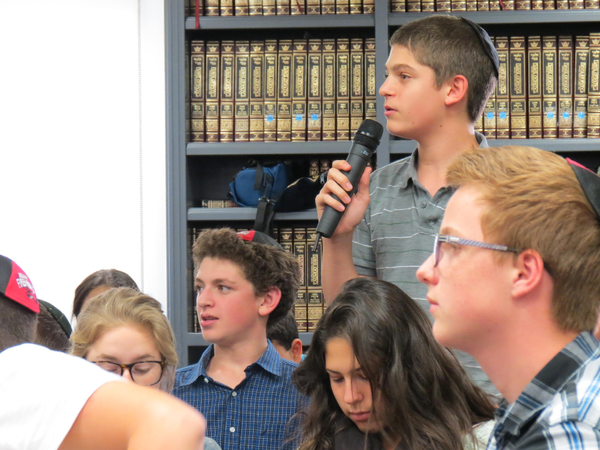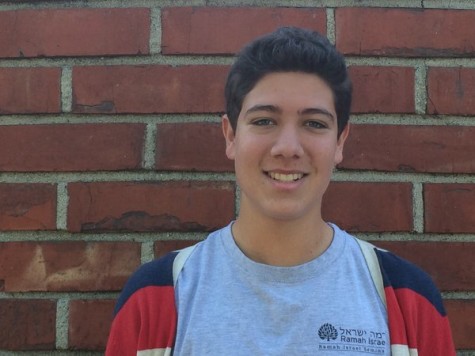Girls will not wear tefillin at Shalhevet, Rabbi Segal decides

CONTROVERSY: Freshman Zev Kent expresses opinion at Town Hall Oct. 31.
November 16, 2013
Three weeks after his initial email raising the question to the Shalhevet community, Rabbi Segal announced Nov. 14 that he would not let female students wrap tefillin and wear tallit at Shacharit, but would encourage them to do so at home or at a nearby synagogue and come to Shalhevet for the rest of the day.
“Ultimately, I have made the difficult decision not to allow this young woman to wear her tefillin at a Shalhevet tefilla group,” Rabbi Segal said in a lengthy e-mail, saying he felt torn between the two options.
But he added that he would take the girl’s davening with tefillin seriously enough to apparently excuse her from Shacharit at school, citing a similar decision made by Rabbi Haskel Lookstein of The Ramaz School in New York City.
“I would make the same offer that Rabbi Lookstein once made in a similar case at Ramaz,” Rabbi Segal wrote, “and offer her the opportunity to put them on at a nearby synagogue or to put them on at home and then come to school to receive the best Judaic education in Los Angeles.”
Rabbi Segal further said that “legitimate halachik and rabbinic sources … suggest permitting the practice,” and that that fact had made two things possible: first, the public discussion of the topic at school, and second, his decision to encourage and recognize her wearing tefillin outside of Shalhevet.
But ultimately, maintaining a Modern Orthodox school that could draw from a range of beliefs and practices made letting her do so at Shalhevet “not wise.” Read the full text of Rabbi Segal’s e-mail here.
“While there certainly exist legitimate halachik and rabbinic sources that suggest permitting the practice of women wearing tefilin (hence my willingness and desire to discuss the issue publicly and my encouraging her to wear tefilin at a synagogue), Shalhevet is a school that draws from a broad spectrum,” Rabbi Segal wrote in the e-mail’s key sentence. “In order to maintain that diversity, there will be times when something might be technically permitted but not wise to allow.”
In his e-mail, which was sent out at 8:40 pm on Thursday evening, Rabbi Segal said he was glad Shalhevet had debated the issue, though he noted that others criticized that, too. The topic was aired not only through community e-mail, but in Town Hall and other discussions among students, faculty and parents.
One person who spoke at Town Hall last month was junior Sigal Spitzer.
“I think Rabbi Segal made the right decision for the school and community at this time,” said Sigal in an interview Friday. “Sadly this is the case, but the Los Angeles community is not ready to have Modern Orthodox school allow a girl to wrap tefillin.”
Rabbi Segal also included excerpts in his e-mail from replies he had received in response to his original question, which was posed in a weekly “From the Virtual Desk of Rabbi Ari Segal” message Oct. 15.
One person wrote, “I think the question is ‘what do you want Shalhevet to be?’ Do you want it to be a viable option for the Orthodox community in Los Angeles, or are you trying to change the way the community views Orthodox Judaism? Unfortunately I don’t think you can do both.”
That comment closely mirrored Rabbi Segal’s original observation that the question created a “no-win situation” for the school.
“I believe that raising this topic in the weekly email… not only was acceptable but of paramount importance,” Rabbi Segal wrote.
“I believe strongly that we can, and will, build a serious yet diverse and tolerant Modern Orthodox school while teaching the community that we should be able to debate issues,” he wrote, “even when those issues make us uncomfortable.”
He added that there were “people I care about and respect deeply” who thought he should not have raised the issue publicly, because even discussing it would discourage students from applying to Shalhevet. Sigal Spitzer strongly defended the public discussion.
“While Rabbi Segal did have to make his judgment based off of public opinion and communal values, I respect the way he went about the process and strived to receive feedback and criticism from leaders not only in Los Angeles but other Modern Orthodox areas around the country,” Sigal said.
“I trust Rabbi Segal’s halachic view as a rabbi and we must realize that he is not only representing his own Jewish opinion but is also representing a larger institution.”
Related story: Mother and daughter who sparked tefillin debate respond to Rabbi Segal’s decision
Related story: Some variety in how Modern Orthodox schools see tefillin issue
Related story: Lively Town Hall debate explores whether girls should be allowed to wear tefillin at school
This story is part of coverage that won 2nd prize in the Boris Smolar Award for Excellence in Enterprise or Investigative Reporting of the 2014 Simon J. Rockower Awards, given by the American Jewish Press Association, in the category of newspapers with under 15,000 circulation.













